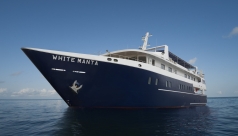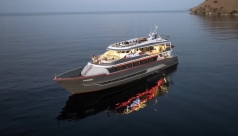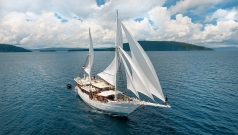Dive Destinations
Liveaboards
Resorts / Day Trips
Scuba Training
...Highlights: whale sharks, hammerhead sharks, shark action, manta rays, turtles, schooling fish & big pelagics, great macro life/ marine diversity, non diving activities...
...Diving environment: healthy reefs, walls, drift diving, advanced divers, off the beaten track...
Generally accepted to be the world's best country for diving scuba trips, Indonesia has more marine diversity than anywhere on earth. Slap bang in the middle of the 'Coral Triangle' of diversity that extends from Australia to the Philippines and across to Borneo and into the South Pacific, this country is at the core of the ocean's heart, where the marine variety suggests life in the sea began.
With 20% of the world's coral reefs, over 3,000 different species of fish and 600 coral species, deep water trenches, volcanic sea mounts, World War II wrecks, and an endless variety of macro life, making diving vacations in Indonesia both excellent and inexpensive.
You can dive here now and experience all the wondrous fish and other marine life in these nutrient-rich seas. From encounters with big pelagics around the cool waters of Komodo, drifting over pristine fields of coral in Raja Ampat, marvelling at the enormous volumes of fish in the Banda Islands, to photographing the outrageous critters of Sulawesi, Indonesia's diving cruises are insurpassable.
There are packages to suit all needs including resort diving in Bali, North Sulawesi and Raja Ampat, where you can stay in comfort on the doorstep of world-class dive sites where marine biologists, photographers and pleasure divers come to marvel at the incredible number, variety and uniqueness of the marine species.
For many, the best diving available is on one of the Indonesia liveaboards to Raja Ampat or Komodo, the country's 2 main liveaboard diving destinations. Raja Ampat cruises allow you to explore the most biodiverse waters on the planet, diving pristine, remote sites with all the comfort and ease that a liveaboard safari provides. Komodo is a prime destination offering liveaboard experiences to suit all budgets and delivering vibrant colourful reefs, plenty of fish action, as well as the promise of encounters with mantas, sharks and more, plus of course land visits to see Komodo dragons. Some trips will take you further afield to places like Cenderawasih Bay or Triton Bay in West Papua, the Banda Islands, Sangalaki, Ambon and Alor, where boats are few and only genuine pleasure-seeking divers are to be found. Fantastic times are virtually assured.
Further details on each of the best diving destinations in Indonesia:
Being such a vast and varied destination, the diving in Indonesia is very difficult to limit to just a few highlights but any consideration of a dive trip here should bear in mind at least the following areas:
One of the few destinations left which truly allows you to feel like you are a pioneer - to boldly dive where no man has dived before. You can marvel at the incredible topside scenery of West Papua, sail through waters where so few boats venture and experience some of the most impressive scuba diving in Indonesia ... and therefore the world. For those who want to get away from it all and dive in a remote paradise but not compromise on comfort then Raja Ampat liveaboards are the choice for you.
> [More details: Raja Ampat]The islands of myth and legend where dragons roam, are surrounded by rich nutrient-filled waters where a kaleidoscope of colour and life awaits scuba divers. Mantas, dolphins and sharks compete with critters galore, all against a riot of soft coral colours. Komodo liveaboard trips allow you to visit the many varied sites around this awesome marine park, some starting in Bali and visiting all the best sites along the way.
> [More details: Komodo National Park]The island is home to some of the most varied and incredible diving in the world. To dive from Manado in the Bunaken National Marine Park means being surrounded by marine bio-diversity that is the envy of the world - with more varieties of coral than anywhere else. Ocean currents sweep nutrient rich water around Bunaken island meaning an abundance of marine life from tiny crustaceans to sharks and rays. Dive sites range from walls to reef flats to critter hunting in the sand. Bunaken is among the most rewarding and relaxing diving in Indonesia, and suitable for all experience levels.
A short drive from here is the Lembeh Strait - the undisputed King of muck diving destinations. This small calm stretch of water is where macro-photographers and critter hunters agree offers the most impressive diving. Along the black sandy floor you will encounter more bizarre and fascinating marine creatures than you could wish for. This is why many divers return time and again to Sulawesi, an Indonesian island where you can fulfil all your dive dreams.
The Banda Sea may be located between the better known destinations of Komodo and Raja Ampat, but for those in the know it deserves its own reputation as one of the world's best dive regions. Scuba diving in Banda means experiencing incredible variety of both large and small. Big pelagics and large schools abound. The reefs are healthy and thriving. Consider on top of this that many different species of whales and dolphins are often sighted, and you begin to get the picture. Diving here is varied, colourful and fascinating.
The Banda Sea is covers a huge area and the diving varies greatly from place to place. Many Banda Sea trips use the port of Ambon which is something of a macro haven. Here you can dive in Ambon Bay along the dark sandy floor beneath local fishing boats. Scraps are tossed into the sea from these boats making the waters a veritable banquet for all sorts of weird and wonderful critters. These include Ambon scorpionfish, fingered dragonets, thorny seahorses and multiple moray eel species - as many as 10 distinct species! There is plenty of wonderful muck diving in Indonesia, and Ambon Bay is up there with the very best.
> [More details: Banda Islands]This is a diving region rising in reputation in eastern Indonesia, otherwise known as the south east Moluccas. This eastern section of the Banda Sea is often dived alongside Alor (to the south) or Raja Ampat (to the north). Few liveaboards venture here, so you will feel like a pioneer diving around islands like Wetar, Nila, Damar, Sermata and Tanimbar. There is often excellent visibility as you dive drop-offs, reef flats and pinnacles. Highlights include schools of hammerhead sharks (September to November), whale sharks, bumphead parrotfish, plus large schools of big-eye trevally and barracuda. There are also plenty of macro delights in the pristine reefs to keep you enthralled when the big pelagics are not in sight.
> [More details: Forgotten Islands]Lying to the south east of Raja Ampat in Indonesian West Papua, Triton Bay is often included in those liveaboard safaris which include the Banda Sea and/or Raja Ampat. It is an excellent dive region in its own right with fabulous soft coral coverage, vast forests of black coral, big schools of fish, epaulette sharks, turtles, whale sharks, pilot whales and more. The topside scenery, with its vaulting cliffs, lush verdant foliage and ancient cave paintings, also contribute to it being a unique and unforgettable destination.
> [More details: Triton Bay]Further northeast from Raja Ampat in West Papua lies the large and increasingly famous Cenderawasih Bay. It is best known for incredible scuba diving opportunities with large numbers of whale sharks. There are also several World War II wrecks to investigate and some top class muck diving locations with critters galore. Year upon year, as its reputation grows, more divers are experiencing the wonders of Cenderawasih.
> [More details: Cenderawasih Bay]Indonesia's most famous tourist resort island has plenty of options for scuba divers of all levels of experience. Deep walls, drift dives through deep water channels, coral reefs, volcanic muck diving, a world famous wreck, offshore islands, mola mola and mantas, superb island scenery and affordable prices. No wonder Bali remains a popular dive destination of choice for many.
> [More details: Bali]Moving east from Komodo you will find the islands of Alor and Flores which, together with other little surrounding islands form an excellent diving region. Less visited than some of its better known neighbours, Alor and Flores liveaboard trips promise some top quality Indonesian diving without the competition for space that can be seen elsewhere. Varied dive sites, superb macro-life, a low human population and excellent visibility make this a relatively undiscovered gem of a diving destination. Sharks, schooling fish, critters like pegasus and bobbit worms, plus underwater lava flows all contribute to this Indonesian dive experience.
> [More details: Alor]This island and its neighbouring islands of Maratua, Kakaban and Derawan are a remote diving region off the east coast of Indonesian Borneo. More liveaboards have begun to visit the region in recent years attracted by the promise of manta rays, whale sharks, meaty pelagics, large schools of fish and pristine reefs. Add to this snorkelling in the jellyfish lake of Kakaban and some great macro sites, and it is clear why this up-and-coming region is viewed as a leading diving destination in Indonesia.
> [More details: Sangalaki]It all depends on the type of scuba diving you want to do. We recommend that you consider 2 ways:
Liveaboard cruises in Indonesia are always a top choice for those who want to see more than any land-based stay can offer. These tours can take you east from Bali to the legendary island of Komodo, or into the inspiring frontier territory of West Papua and the Banda Sea. Breathtaking diving, fantastic boats and inspiring topside scenery all await you here: Alor-Flores, Banda Sea, Cenderawasih Bay, Komodo, Raja Ampat, Triton Bay, Wakatobi, Transit Trips.

Customer rating: Excellent!

Customer rating: Excellent!

Customer rating: Excellent!

Customer rating: Excellent!

Customer rating: Excellent!

Customer rating: Excellent!

Customer rating: Excellent!

Customer rating: Excellent!

Customer rating: Excellent!

Customer rating: Excellent!

Customer rating: Excellent!

Customer rating: Excellent!

Customer rating: Very good!

Customer rating: Very good!

Customer rating: Very good!

Customer rating: Very good!

Customer rating: Very good!

Customer rating: Very good!

Customer rating: Very good!

Customer rating: Very good!

Customer rating: Very good!

Customer rating: Very good!

Customer rating: Very good!

Customer rating: Very good!

Customer rating: Good

Customer rating: Good

Customer rating: Good

Customer rating: Good

Customer rating: Good

Customer rating: Good

Customer rating: Good

Customer rating: Good

Customer rating: Average

Customer rating: Be first to rate!

Customer rating: Be first to rate!

Customer rating: Be first to rate!

Customer rating: Be first to rate!

Customer rating: Be first to rate!

Customer rating: Be first to rate!

Customer rating: Be first to rate!

Customer rating: Be first to rate!

Customer rating: Be first to rate!

Customer rating: Be first to rate!

Customer rating: Be first to rate!

Customer rating: Be first to rate!

Customer rating: Be first to rate!

Customer rating: Be first to rate!
 Bastianos Lembeh Resort
Bastianos Lembeh Resort
Customer rating: Excellent!
 Lembeh Resort
Lembeh Resort
Customer rating: Excellent!
 Sorido Bay Resort
Sorido Bay Resort
Customer rating: Excellent!
 Tulamben Wreck Divers
Tulamben Wreck Divers
Customer rating: Excellent!
 Bastianos Bunaken Resort
Bastianos Bunaken Resort
Customer rating: Very good!
 Bunaken Cha Cha Resort
Bunaken Cha Cha Resort
Customer rating: Very good!
 Tasik Ria Dive Resort
Tasik Ria Dive Resort
Customer rating: Very good!
 Bali Island Dive Daytrips
Bali Island Dive Daytrips
Customer rating: Good
 Kri Eco Resort
Kri Eco Resort
Customer rating: Good
 Kubu Indah Resort
Kubu Indah Resort
Customer rating: Good
 Lembongan Dive Day Trips
Lembongan Dive Day Trips
Customer rating: Good
 Misool
Misool
Customer rating: Good
 Siddhartha Dive Resort
Siddhartha Dive Resort
Customer rating: Good
 TWD Villas
TWD Villas
Customer rating: Good
 Agusta Eco Resort
Agusta Eco Resort
Customer rating: Be first to rate!
 HamuEco Dive Resort
HamuEco Dive Resort
Customer rating: Be first to rate!
 Manado Dive Daytrips
Manado Dive Daytrips
Customer rating: Be first to rate!
 Meridian Adventure Dive
Meridian Adventure Dive
Customer rating: Be first to rate!
Alternatively, our dive resort stays in Sulawesi, Bali and Raja Ampat will allow you the opportunity to base yourself close to some of the finest dive sites in the world: Bali, Raja Ampat, Sulawesi.
Additionally, for those of who prefer to book their own accommodation, we offer diving daytips in Lembongan (near Bali), to Komodo (from Labuan Bajo, Flores), and from Manado (to Lembeh Strait, and Bunaken and Bangka islands).
You can dive in Indonesia at any time of the year and there are liveaboards operating in various parts of the country throughout the year. With such a vast and geographically diverse country, it is impossible to give general guidelines. What is possible is to state that Indonesia, being at the heart of the Coral Triangle, boasts unbelievable biodiversity and across the range of destinations within the country, an amazing array of choice. Where in the country you choose to go and at what time of year depends on many factors, not least what type of scuba diving and creature encounters you are seeking.
Komodo has year round diving with some people considering April to November to have the very best conditions, and August in particular being the best month for Mola Mola. Outside of this time plankton blooms may reduce visibility a little but this increases the chances of manta ray encounters which are most frequent between December and February.
Raja Ampat and the West Papua Province have some liveaboard charter boats operating all year although many restrict their season to October to April when there is less chance of rain and choppy seas. Mantas are more frequently sighted during these months. Sea temperatures do not vary much during the year but the frequency of rain, in this amazing (but relatively wet) destination is a seasonal factor.
North Sulawesi is another destination that can be dived all year round. Manado and the Bunaken National Park enjoy the best conditions from March to October with July and August being the busiest months. July and August are also the best months for critter spotting in Lembeh, although this too can be amazing during any given month. November to January are the months where you can be least certain of great conditions throughout North Sulawesi.
Bali is best dived between April and November, with sightings of Mola Mola, sharks and other pelagics tending to be most frequent between June and September, and manta rays between April and June. Outside of this time is officially rainy season, although conditions are often excellent during then too, with visibility a little compromised off the north and west of Bali where less diving is done.
Visit Wikipedia for a summary on the climate of Indonesia.
Review our maps below of Indonesia and its location in the world. Here, you will find information on how to get to Indonesia.
5 - >40m
10 - 80m
Can be very strong
Calm
19 - 30°C
Intermediate - advanced
~500
2 - 4 weeks
Brilliant and no hassle. Also good advice on the dive sites I should go to after I gave my brief of what I would ideally like. Ability to listen and understand clients needs is an art that not many companies have, but Dive The World sorted me out
